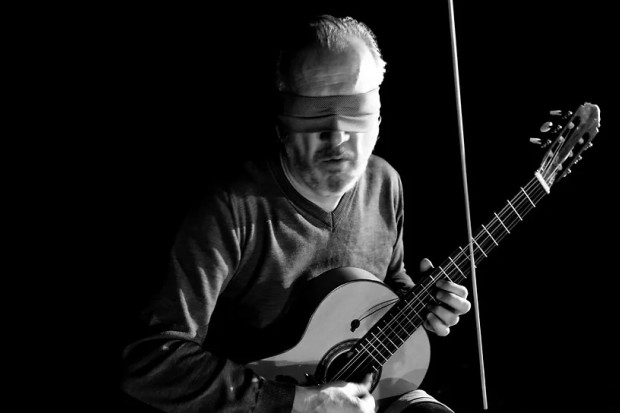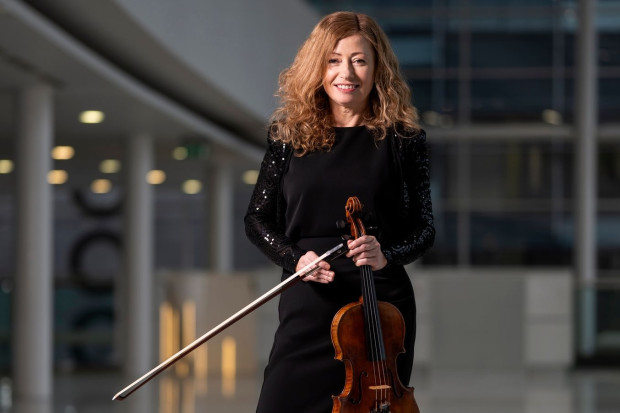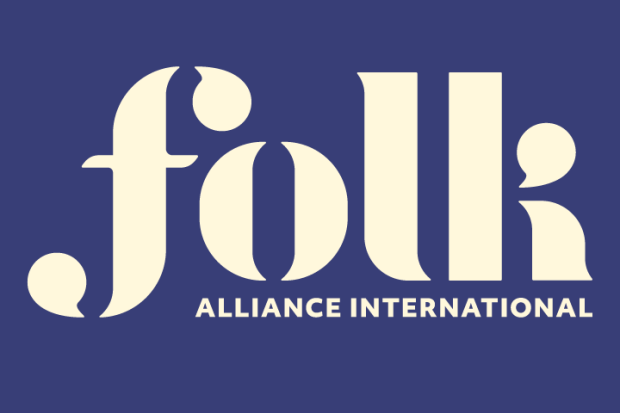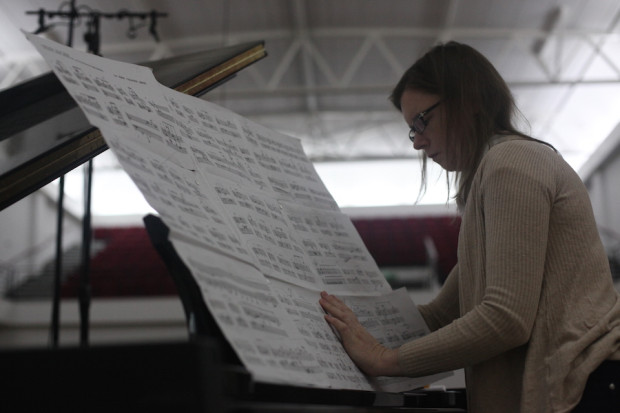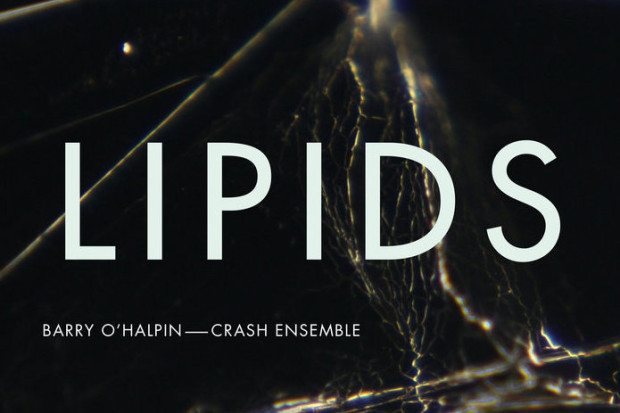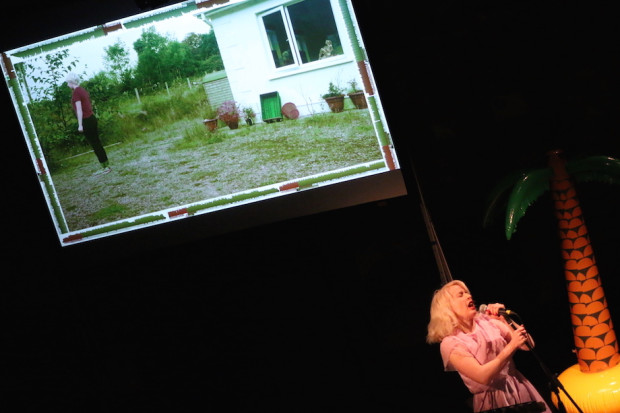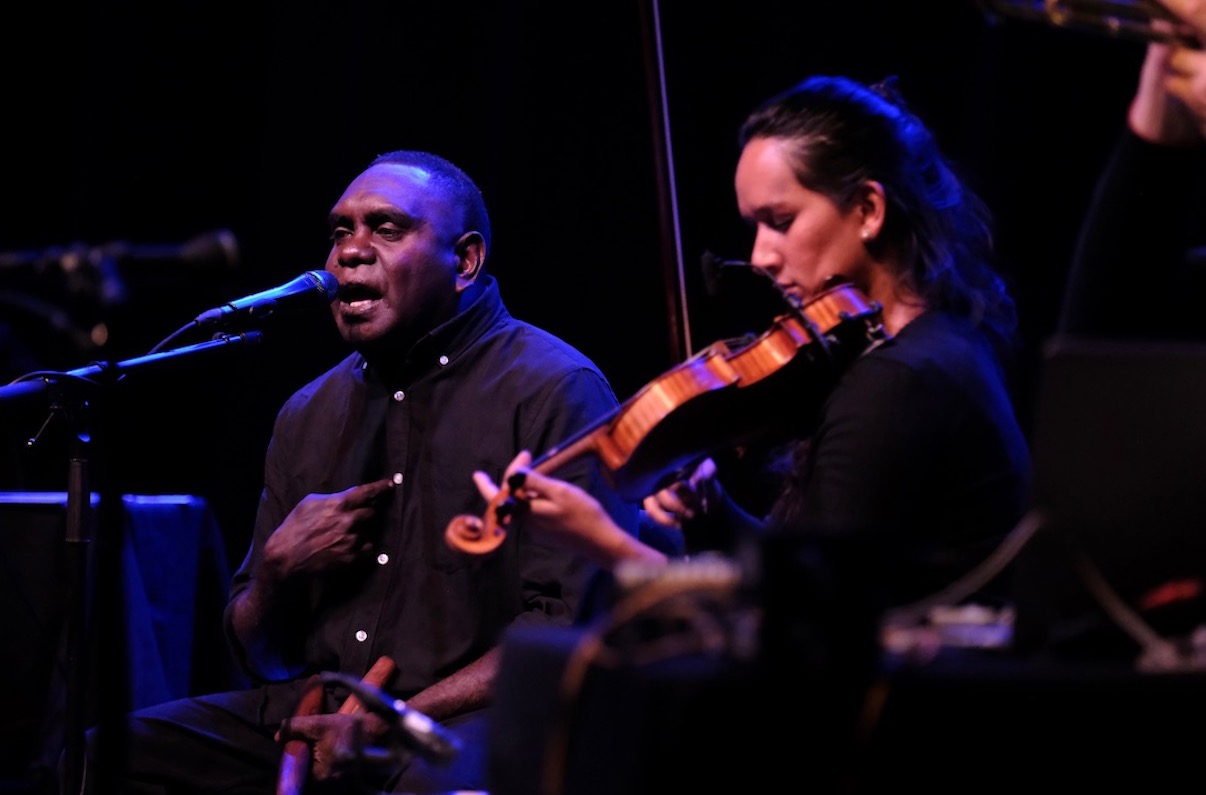
Yolŋu traditional songman Daniel Wilfred, Mandhira de Saram (violin) and Australian Art Orchestra performing 'Fresh Water – Salt Water' at Huddersfield Contemporary Music Festival 2022. (Photo: Brian Slater)
The Things That Keep People Connected
After an online-only festival in 2020, and a half-size, socially distanced event in 2021, the Huddersfield Contemporary Music Festival (hcmf//) returned to its full ten-day span of concerts, films, exhibitions and installations in November. This year was mostly structured around several international collaborations and I visited on the final weekend (25–27 November), which was dominated by a focus on Ireland and Australia.
Ireland: Andrew Zolinsky, Crash Ensemble and Ulysses films
hcmf//’s opening collaboration with Culture Ireland (it will run to 2024) took the form of two concerts and a film screening/installation. The concerts were a performance by pianist Andrew Zolinsky and Crash Ensemble’s live premiere of Barry O’Halpin’s Wingform (2021). (The two other parts of this programme, Jennifer Walshe’s SELF-CARE (2017) and Red Note Ensemble’s concert of music by Ann Cleare, Nick Roth, and Úna Monaghan, took place the weekend before I attended.)
Zolinsky’s concert opened with the world premiere of Tracing (2022) by Lilja María Ásmundsdóttir. This work moved from haunting to precipitato to nostalgic, and was replete with brilliant ideas (especially the use of rubbed bamboo shoots against the strings of the piano) – but it was undisciplined, with rough transitions and a trite ending of a repeated arpeggio figuration. Another youthful work was Barry O’Halpin’s brief and rather generic Miniature from 2012. Donnacha Dennehy’s Her wits (about him) (2017) was a rare moment of minimalism in hcmf//.
The highlights of this concert, though, were the premieres of works by Linda Buckley and Chris McCormack. McCormack’s Something other than the fear of falling (2019) opened and closed with a shimmering, crystalline hail of notes in the high register. I was stunned by the pianism of the writing, but sneaking a look at the score afterwards and seeing it full of extremely precise (often nested tuplet) notation that showed it to have been written on the page rather than at the keyboard, the credit here must go to Zolinsky’s virtuosity. The middle section of the piece was not quite as impressive: the pianist is instructed never to lift the pedal, which is rather a blunt tool by which to achieve the intended foggy effect, but there was still a great sense of melody and harmony.
Buckley’s Water Witch (2022) took the ocean, through its Celtic mythological avatar of the Muileartach, as its subject. Buckley reminds us here of her masterful command over vast roiling landscapes, and of co-equal polyphony of electronics and live performance. Moreover, her palette is ever increasing and her colours are getting ever more subtle: I was amazed by the end of the piece, in which the drowning of the Muileartach in calm water is represented by a passage that is somehow simultaneously huge and claustrophobic.
The final Irish contribution was the screening of six short films in the Huddersfield Art Gallery that were based on Joyce’s Ulysses. These were commissioned for the centenary of its publication, and the programme has already toured Ireland and Europe. They were rather a mixed bag, but I was entirely won over by Ultan O’Brien’s Cling(ing) like Fire, a flitting film with all its components falling over each for attention, but which nevertheless has a surprising aesthetic unity; Joyce would have enjoyed its combination of complexity and revelry. I was also impressed by Ed Bennett and Laura Sheeran’s Luminary Reflection, a simple but coherent and evocative work, and Darragh Kelly and Rioghnach Ní Ghrioghair’s Penelope, which used as its text the output of an AI that had been fed Molly Bloom’s soliloquy. It is amusing to see how the nonsense of a stream of consciousness compares to the nonsense of AI text generation, and to wonder what that says about the distance between humans and computers.
I was awestruck by Barry O’Halpin’s Wingform when I saw Crash give it its online premiere at New Music Dublin 2021; live, I was even more taken. This work slowly morphs across a wide spectrum over its hour-long length, from the whining, skittering solo-guitar ‘Grave Goods’ movements to spiky and mechanical tutti movements. It is an uncanny and brittle work whose tension never slackens for a moment. It also has the most inspiring guitar writing I’ve ever heard in a classical context. Crash, again under Ryan McAdams and with O’Halpin again taking the prominent guitar part, matched the seriousness and precision of the work, and played with unstinting emotional focus.

Composer and guitarist Barry O’Halpin, conductor Ryan McAdams and Crash Ensemble following the performance of ‘Wingform’ (Photo: Simon Marshall)
Australia: Australian Art Orchestra, Decibel and Eugene Ughetti
The Australian programme at hcmf// was part of the first of three years of UK/Australia Seasons in Huddersfield. The largest part of this was the two concerts by the Australian Art Orchestra (AAO). The first of these was a series of three extended solo improvisations by bassist and vocalist Helen Svoboda, clarinettist Aviva Endean, and trumpeter and artistic director Peter Knight. These were great performances by singular musicians. Svoboda plays and sings with astonishing grace and weightlessness, using harmonics and well-judged light electronics to create something that has both keening and dance to it. Following this warm and very musical set, Endean’s performance was more theatrical and more sound art, especially at the beginning when she focused on the sound of the clarinet’s mouthpiece modulated through unpitched lengths of pipe. The set then built, via a gorgeous extended perpetuum mobile, to a full climax that was then matched by Knight’s trumpet set which, though it started with barely audible rasps, soon became a beefy orchestra study of harmonisers, loops, delays and other textural effects. If this minimalist set occasionally got stuck in ruts, it also created some glorious sounds.
But it was the second concert that was the real reason for the AAO’s tour. Over the summer, British musicians Cath Roberts and Mandhira de Saram visited Australia to work on a large-scale piece with the AAO and two Indigenous Australian musicians – specifically, Yolŋu traditional songmen – David and Daniel Wilfred. The resultant work, Fresh Water – Salt Water, which emerged from a series of workshops there, was then brought to Huddersfield as a completion of the UK/Australia partnership. It was a fascinating work: opening with a forceful overture, the eight assembled and amplified musicians covered a huge emotional spectrum over the course of the work’s seventy minutes, guided by Daniel Wilfred’s traditional song cycle that charts a journey along a songline from the Walker River from the sea to a drinking-water billabong.
Fresh Water – Salt Water is a torrent of sound and emotion that I thoroughly enjoyed. It is great, too, to see any attempt to bridge the appalling gap between non-Indigenous and Indigenous Australia. It was not a perfect work, though. One of the most exceptional songs was ‘Wata’: Cath Roberts’s baritone saxophone’s overblowing harmonised with the shifting overtones of David Wilfred’s didgeridoo, creating a perfect bed for Daniel Wilfred’s plaintive singing. It showed miraculous unity, respect, and mutual listening between the performers. But this cast into relief how at many other points the musicians played more or less as they normally do – which is great so far as it goes, but did not lead to the kind of groundbreaking synergy one might have hoped for from this project. I understand that the performance changed significantly since Australia, and I would love to see the musicians further refine this work that has huge political and artistic potential but which is concomitantly difficult.
The third Australian concert was by Decibel, who played several works by the ensemble’s founder, Cat Hope. There was a common thread through the works: they were slow and careful, with a restricted registral range. I found the focus rather monomaniacal: the most interesting work was Sogno 102 (2012) for full ensemble, in which the addition of a vibraphone contributed to a wider and more interesting sonic palette.
Percussionist and composer Eugene Ughetti rounded out the Australian representation. He had two contributions. First, he performed with charisma and seriousness a concert of five diverse pieces by various Australian composers. I was particularly struck by three of them. Thomas Meadowcroft’s March Static (2018, rev. for live performance 2022) for snare drum and electronics was a parody of military marches – Ughetti marched around the room to play in various combinations with the taped percussion – that was yet full of musicality. Nina Buchanan’s Outward Pressure (2022) for drumkit and electronics had a fantastic, slippery techno groove to it, with an especially rivetting hocket between Ughetti’s floor tom and an electronic ‘tom’. Finally, Liza Lim’s An Elemental Thing (2017) for woodblock was a charming, cheeky study in sound, coaxing surprisingly human moans and groans from it.
Ughetti’s other contribution was the installation Polar Force – Array, co-composed with Philip Samartzis and written on foot of a residency in Casey Base research station in Antarctica. In Huddersfield town hall, an icily backlit tent filled a room; walking into it, you heard an eight-channel recording of sounds that were ambiguously field recordings or musical instruments. It was one of the most talked-about events of the weekend, and rightly so: you felt yourself transported, just a thin sheet of protective fabric from the ominous but beautiful sounds of the alien Antarctic landscape. It was a study in the sublime, kept just out of view, but it was also a reflection on the overwhelming power of a changing climate and how thin (and wearing thinner) civilisation’s protection against it is.

Daniel Wilfred performing ‘Fresh Water – Salt Water’ (Photo: Brian Slater)
UK: Pat Thomas, Steve Beresford, Phil Durrant, David Toop and Mark Westell
In addition to the Irish and Australian programmes, hcmf// collaborated with Ukraine, Lithuania, and Sweden. I missed the ‘archaeological opera’ Chernobyldorf that was perhaps the major event of the festival, as well as several composers that were given spotlights: Philip Venables, Justė Janulytė, and the composer in residence Lisa Streich.
As well as all this, hcmf// also hosted a number of British luminaries. Pat Thomas, the great free jazz pianist, played a solo improv set on the Saturday evening. There was great mirth and freedom in Thomas’ playing, and even when blasting out huge clusters with his entire forearm the piano sounded warm, full and clear. He played with the piano, sculpting its intrinsic rhythmicality and dynamic height – sometimes he played it as if it were a cannon, something unpitched and massive – and when relatively conventional fragments of Duke Ellington or George Gershwin emerged from this, they were enriched by it, and returned to it as if falling into a party.
Friday saw the publication of a new book by Mark Hudson about the Scottish abstract expressionist painter Alan Davie (1920–2014), who was also active in the British jazz scene. That night saw a companion concert: film footage of Davie painting in 1960 and 1961 was shown supported by an improvisation by Steve Beresford, Phil Durrant, David Toop, and Mark Westell. Davie’s painting style, certainly in this period, has obvious affinities to musical improvisation, and the film–performance combination brought this out. This was not only in nice serendipities, as when Wastell, whose instruments were laid out on the floor of the stage, at one point exactly mirrored a gesture of Davie’s, whose canvases were laid out on his own floor. It was also, for instance, in how the four semi-independent improvisers captured something of Davie’s (aspirationally, at least) ego-less simultaneous painting of several canvases; and it was in how they eschewed a strong sense of progression to mirror Davie’s searching gaze and endless reworking and overpainting: circling back around the same ideas in the hope that in them can be found something as yet non-existent.
hcmf// has always been conscious of the town of Huddersfield, even though it is primarily hosted by the university, and every year it makes attempts to broaden its appeal. This year, tickets for under-30s were a heavily discounted £5; there were a host of free concerts on the Monday; a few free events were programmed, some for women and gender minority participants only; and there was a tour of Huddersfield University’s archive, which is notable for having the largest collection of twentieth-century British art music in the world. This last was a delight; I had great fun rummaging through the archive box labelled ‘experimental / non-standard notation’ and listening to Joëlle Léandre’s 1982 work for female double bassist, Taxi, in which the performer recounts things taxi drivers says to her when they see her double-bass. Plus ça change, I am told.

Steve Beresford, Phil Durrant, David Toop and Mark Westell in ‘Alan Davie: Painting, Music, Film’. (Photo: Simon Marshall)
Mark Fell + Explore Ensemble
The festival ended with what I found to be one of its most difficult pieces, Mark Fell’s Every non-empty ultra-connected compact space has a largest proper open subset (2022), performed by Explore Ensemble. Fell’s background is in electronic music and sound art, and this may be his first substantial work for acoustic instruments. For this work (an hour in this iteration), the six musicians were spread out on a line that bisected the entire hall. They were unable to communicate with one another and each performed from a part that they created from the score without collaboration. So it was a piece of aleatory music – but in such music as created by Cage, say, the interest often lies in the moments of serendipity that happen despite not being directly intended. When a composer incorporates whatever happens to be broadcast on commercial radio into a piece, the composer is not in control of the specific sounds made, but as radio is full of things with meaning (whether chatter or music), there is a good chance that it will interact in an interesting way with whatever other elements the composer puts in the piece. In Every non-empty ultra-connected compact space has a largest proper open subset, though, there seems to have been a concerted effort to inhibit such serendipities: for an hour, the audience is left looking at disconnected, subdued musicians, the most physically distant from me fading into the muted hubbub of Huddersfield town that was played through a dozen speakers circumscribing the hall. I hear the work as a depiction of isolation (the fact that it was written during lockdown is no surprise) and even failure of communication – it is true that there can be no ‘failure’ if there is not even an attempt at communication, but note that Fell wrote this piece for an ensemble rather than six soloists: he seems to be taking something fundamentally collaborative and communicative and sticking knives through it. It was a bitter piece, and one wonders why festival director Graham McKenzie ended the festival here rather than on, say, the jubilance of the previous night’s Fresh Water – Salt Water, or with the party it ended with when I last attended in 2018.
Perhaps, as one festival-goer suggested to me, Every non-empty ultra-connected compact space has a largest proper open subset is putting a question to the next festival: tearing an ensemble maximally far apart, that we might rethink ‘together’. I don’t disagree, but I would add that it struck me as one with the fear and trepidation many feel in the UK at the moment, where the economic outlook is unusually bleak. There was a sense throughout the festival that people and institutions are worrying, hanging on, hoping they can persevere, rather than (as last time) striding forward; there was a fear that the things that keep people connected are in danger of splitting apart because no-one can afford to support them. In this context (and McKenzie has an acute ear for such things), a triumphant or blithely optimistic finale would have rung false – and even the ugliest sounds of art music must ring true. Walking home from this last concert of the festival, I felt uneasy and frustrated. But sotto voce, I also felt invigorated.
Visit https://hcmf.co.uk.

Explore Ensemble performing Mark Fell’s ‘Every non-empty ultra-connected compact space has a largest proper open subset’ (Photo: Brian Slater)
Subscribe to our newsletter.
Published on 8 December 2022
James Camien McGuiggan studied music in Maynooth University and has a PhD in the philosophy of art from the University of Southampton. He is currently an independent scholar.












